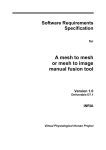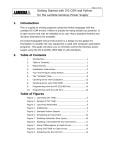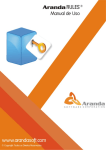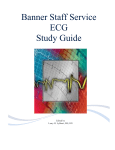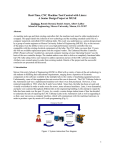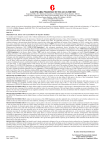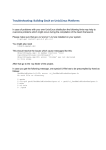Download simECG user`s manual - The UK Mirror Service
Transcript
simECG User’s Manual Version 1.0 June 2009 Table of contents 1.What is simECG..................................................................................................................1 2. Installation..........................................................................................................................1 2.1.Supported platforms................................................................................................................1 2.2.Linux platform binary...............................................................................................................1 2.3.Windows platform binary.........................................................................................................1 2.4.From source code...................................................................................................................1 3.Features..............................................................................................................................2 3.1.Signal presets.........................................................................................................................2 3.2.Custom settings......................................................................................................................2 3.3.Assess your knowledge..........................................................................................................3 4.simECG interface................................................................................................................3 4.1.Menus.....................................................................................................................................3 4.1.1.File...................................................................................................................................3 4.1.2.Preferences......................................................................................................................4 4.1.3.Help..................................................................................................................................5 4.2.ECG plotter.............................................................................................................................6 4.3.Tabs........................................................................................................................................6 4.3.1.Presets.............................................................................................................................6 4.3.2.Custom settings................................................................................................................7 4.3.3.Assessment......................................................................................................................8 5.Credits.................................................................................................................................9 simECG 1. 1 What is simECG simECG is an ECG signal simulator aimed for basic training and experimenting. As a full software ECG signal generator, it's ideal for training and demonstration purposes. You can create customizable signals usually present in many pathologies. If you need more information, or wish to participate in the simECG community, please go to the project web page at http://simecg.sourceforge.net 2. Installation 2.1. Supported platforms SimECG is released in binary format for the following platforms: • Linux • Microsoft Windows The most recent binary releases are always maintained in the Sourceforge project page https://sourceforge.net/project/platformdownload.php?group_id=263385 Source code: The program can be compiled in any of the Qt4 supported platforms (http://www.qtsoftware.com/products), such as Apple Mac OS X among others. For those cases, you must have Qt4 development environment installed, and obtain the simECG source code. 2.2. Linux platform binary The released binary is inside a tar gzip file, and will require Qt shared libraries to run. Please make sure you have libqt4 installed in your computer. 2.3. Windows platform binary The simECG files are distributed inside a .zip file. Just unpack into a directory of your choice. There are no special requirements. In some special cases, you could need msvcrt.dll in order to run simECG.exe. 2.4. From source code You will need Qt version 4 developer libraries from your target platform in order to compile the source code. Just 'qmake' in the source code directory and a binary will be built. If you find any trouble during compilation for your platform, please contact the developers, or post questions and suggestions in the project developers mailing list. simECG 3. 2 Features simECG has several features, that allows you to display predefined ECG signals from the following list: 3.1. Signal presets • Sinus rhythm; • • Sinus bradycardia; Sinus tachycardia; • • Atrial fibrillation (not implemented in this version); Fast atrial fibrillation (not implemented in this version); • • Junctional rhythm; Accelerated junctional rhythm; • • Idioventricular rhythm; Accelerated idioventricular rhythm; • • Isolated PAC (not implemented in this version); Paired PAC (not implemented in this version); • • Supraventricular tachycardia; Sinus pause (not implemented in this version); • • Type I 2nd degree SA block (not implemented in this version); Isolated monomorphic PVC (not implemented in this version); • • Isolated polymorphic PVC (not implemented in this version); Monomorphic VT; • • Polymorphic VT (not implemented in this version); Ventricular fibrillation; • • First degree AV block; Type I 2nd degree AV block (not implemented in this version); • • Type II 2nd degree AV block (not implemented in this version); Second degree AV block - 2:1 (not implemented in this version); • AV dissociation. 3.2. Custom settings • • Heart rate; PR interval; • • • P wave: duration, amplitude and polarity; QRS complex: duration, amplitude and morphology (not implemented in this version); T wave: duration, amplitude and polarity; • • PAC: number and coupling interval (not implemented in this version); PVC: number and coupling interval (not implemented in this version); simECG 3 3.3. • Special conditions: type I and II 2nd degree AV block; AV dissociation (not implemented in this version); • Other conditions: atrial fibrillation (not implemented in this version). Assess your knowledge Additionally, in later versions, it will be possible to define certain preferences such as calibration, filters, display and background as well as to save/load your preferences and training settings. 4. simECG interface The simECG simulator comprises several interactions, as shown in the following screenshot. We will describe those menus in more detail. 4.1. Menus 4.1.1. File In the File menu you can save and load your custom settings and preferences. You can also exit the application by clicking Exit. To Load your preferences press File → Load preferences To Save your preferences press File → Save preferences To Load your custom settings press File → Load custom settings simECG 4 To Save your custom settings press File → Save custom settings 4.1.2. Preferences In this Menu you can change all technical specifications of your signal as described ahead. In can also save these settings and load them when you need it (please refer to 5.1.1 - File). simECG 5 4.1.2.1. Calibration In this Menu you can define your signal specific calibration settings, such as speed and amplitude. You can use the standard calibration (25 mm/s and 10 mm/mV) or change speed and amplitude according to your needs. To change Speed just click Preferences → Calibration → Speed and the you can set the values to 25 mm/s or 50 mm/s. To change Amplitude just click Preferences → Calibration → Amplitude and the you can set the values to 10 mm/mV or 5 mm/mV. 4.1.2.2. Filters You can set filters On or Off, according to the needs of your specific training. To set filters On or Off, go to Preferences → Filters. 4.1.2.3. Display According to your training needs you can set the ECG signal to roll, or just keep it static. To set display options click Preferences → Display Filters and then select Static or Rolling. 4.1.2.4. Background If you need "pure" ECG teaching you might like to use the standard pink ECG paper background. On the other hand if you need a more practical approach, for example for rhythm simulation, then the black background monitor is the best choice. To change the Background click Preferences → Background and then select ECG paper or Monitor. 4.1.3. Help Here you can find general information regarding the simECG version and GNU General Public License, as well as information about the authors and contributors. Additionally you can find a disclaimer with general disclosures on simECG. simECG 6 4.2. ECG plotter The ECG plotter monitor is where the signal is presented. Heart rate is displayed on the top right corner. 4.3. Tabs 4.3.1. Presets Here you can define which preset you want to see displayed on the ECG plotter. Several presets can be chosen (please refer to 4. - Features). To change the preset you want to display just click the radio button next to it. simECG 7 4.3.2. Custom settings Here you can change several settings, and build you own signal. • Heart rate : ranges from 30 to 200 bpm; • • PR interval: ranges from 0,08 s to 0,30 s; inactive when AF is checked; P wave: you can set amplitude (0,05 to 0,40 mV), duration (0,04 to 0,14 s) and polarity (positive or negative); inactive when AF is checked; QRS complex: you can set amplitude (0,50 to 2,00 mV), duration (0,08 to 0,16 s) and morphology (normal, RBBB or LBBB); morphology not implemented in this version; • • T wave: you can set amplitude (0,10 to 0,50 mV), duration (0,10 to 0,40 s) and polarity (positive or negative); • PAC: activate checkbox to define number and coupling interval of PAC's; not implemented in this version; • PVC: activate checkbox to define number and coupling interval of PVC's; not implemented in this version; • Special conditions: you can select several special conditions; not implemented in this version; • Other conditions: mark checkbox to activate atrial fibrillation; not implemented in this version. simECG 8 4.3.3. Assessment Here you can assess your knowledge on a user-friendly interface. Just press begin and press the radio button with the correct answer. Then press “Next" to see the next question. Easy, don’t you think? simECG 5. 9 Credits This simulator was developed as an assignment for the course “Sistemas de Informação 1” as part of the Msc of Medical Informatics from University of Porto. SimECG is an open source software, developed under the GPL v3 licensing. SimECG has a Sourceforge project web page at http://simecg.sourceforge.net. The group of authors were: António Cardoso Martins - Programming ([email protected]) Paulo Dias Costa - Scientific Contents & Layout ([email protected]) João Miguel Marques - Design & Graphics ([email protected]) The authors would like to acknowledge the following contributors: ECG Simulation : karthik Raviprakash ([email protected]) Mathematics: Sandra Jardim ([email protected]) Splash Screen Design: Ernesto Aranda ([email protected])











